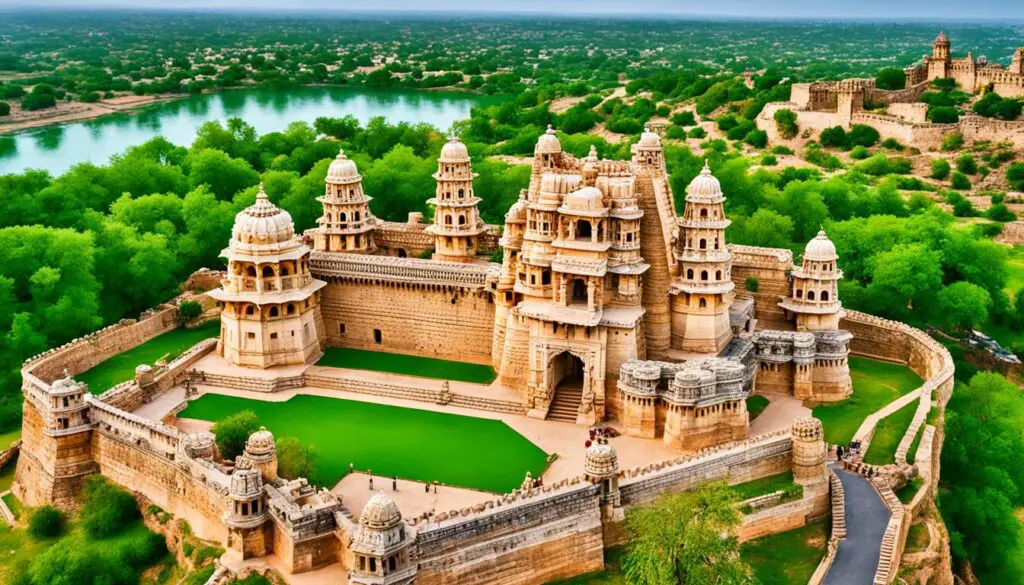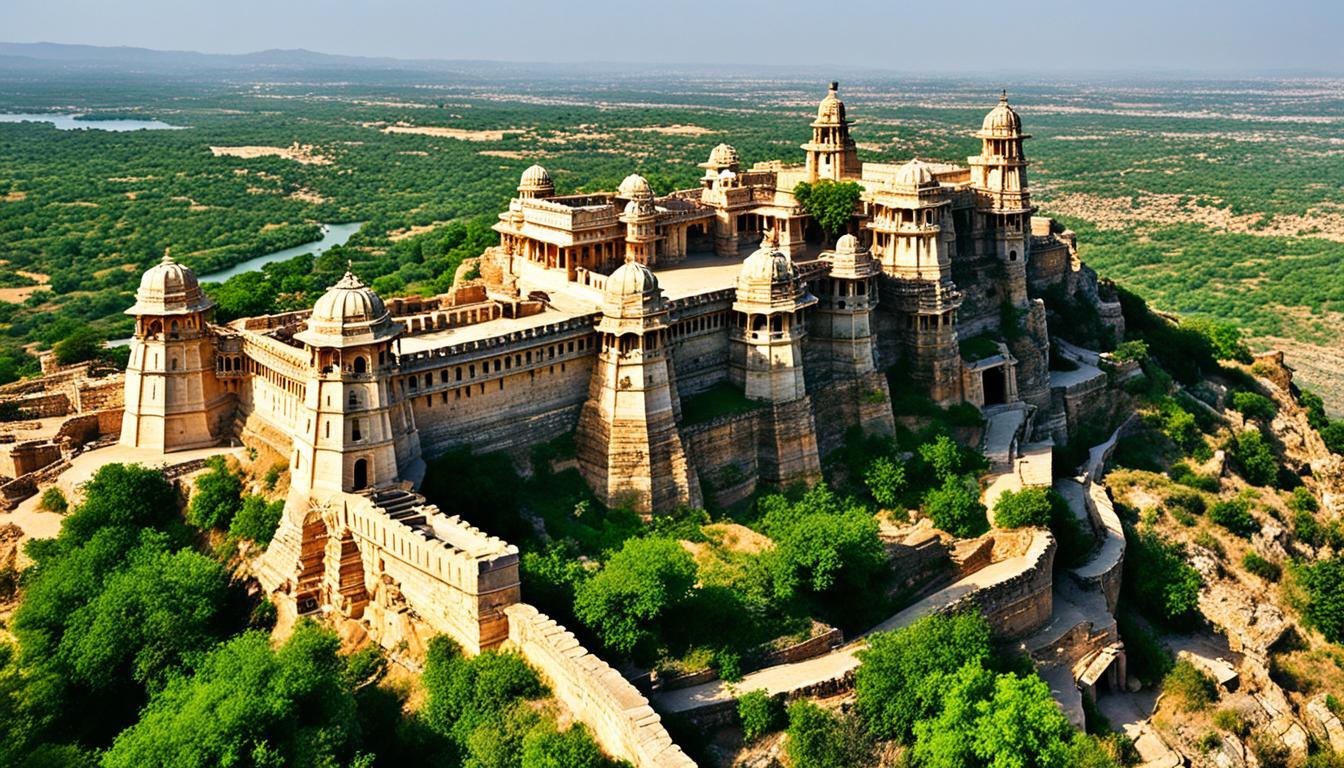Have you ever wondered what it would be like to step back in time and witness the glory of an ancient kingdom? Imagine walking through a fortress that has stood the test of time, bearing witness to legendary battles and the unwavering courage of its defenders. Welcome to Chittorgarh Fort, a UNESCO World Heritage Site that holds the history and architectural splendor of the Rajput warriors.
Perched atop a hill in the city of Chittorgarh, Rajasthan, Chittorgarh Fort is one of the largest living forts in India. Spanning over 280 hectares, it boasts 65 historic structures that include palaces, temples, water bodies, and victory towers. This formidable fort not only showcases the rich history of the Mewar kingdom but also serves as a testament to the unwavering spirit and resilience of its people.
Key Takeaways:
- Chittorgarh Fort is a UNESCO World Heritage Site and one of the largest living forts in India.
- The fort is a treasure trove of history and architecture, with 65 historic structures spread across 280 hectares.
- Chittorgarh Fort serves as a symbol of Rajput valor and resilience, with its walls soaked in the stories of battles and jauhars.
- The fort houses remarkable structures such as the Vijay Stambh, Kirti Stambh, Rana Kumbha’s Palace, Padmini Palace, and more.
- Visiting Chittorgarh Fort is a journey into the past, offering a glimpse into the majestic heritage of India.
History of Chittorgarh Fort
Chittorgarh Fort has a long and storied history. It is said to have been built by Chitrangada Mori, part of the Mauryan dynasty, in the 7th century. The fort came under the control of Bappa Rawal, who established the Mewar dynasty in the mid-8th century. The fort witnessed multiple invasions and sieges, including those by Alauddin Khalji, Bahadur Shah, and Akbar. The Mughals attacked the fort numerous times in their quest for dominance in northern India. The fort was the site of jauhar, a mass self-immolation of women, during these sieges.
Despite the repeated attacks, the Mewar dynasty persevered and continued to rule from the fort until it was shifted to Udaipur. The fort regained its past glory under Rana Kumbha, who built many structures within its walls. It was later handed back to the Mewars in a peace treaty with Jehangir, the son of Akbar.
Key Features of Chittorgarh Fort
Chittorgarh Fort, a true testament to architectural brilliance and historical significance, boasts several key features that captivate visitors from around the world. Let’s explore some of the remarkable structures within the fort:
Vijay Stambh
The Vijay Stambh, also known as the Victory Tower, stands tall as a symbol of triumphant victory. Built by Rana Kumbha to commemorate his conquest over the Sultan of Malwa, this magnificent tower offers a panoramic view of the town. Adorned with detailed inscriptions of Jain goddess Padmavati, Allah, and various Hindu deities, the Vijay Stambh is a visual masterpiece.
Kirti Stambh
Another architectural marvel within Chittorgarh Fort is the Kirti Stambh, or the Tower of Fame. This 12th-century tower is dedicated to the Jain Tirthankaras and showcases intricate Jain sculptures. It stands as a testament to the artistic excellence and religious devotion of the Jain community in the region.
Rana Kumbha’s Palace
Rana Kumbha’s Palace is a magnificent structure known for its architectural beauty and historical significance. Believed to be the birthplace of Maharana Udai Singh, the founder of Udaipur, this palace offers a fascinating glimpse into the opulent lifestyle of the Mewar dynasty. With its exquisite design and intricate details, the palace evokes a sense of grandeur and regality.
Padmini Palace
Padmini Palace holds great historical significance and is famous for the compelling tale of Rani Padmini. It is within the walls of this palace that the jauhar, a mass self-immolation by Rajput women, took place. The palace, surrounded by a serene water body, offers a serene ambiance and takes visitors back in time to relive the valor and sacrifice of the Rajputs.
Meera Temple
Meera Temple, dedicated to the legendary poet-saint Meera Bai, is a place of spiritual significance. It beautifully showcases the Rajput architecture with intricate carvings and stunning sculptures. Visitors can immerse themselves in the serene ambiance of devotion and explore the rich spiritual heritage of the region.
Kalika Mata Temple
The Kalika Mata Temple is a revered place of worship within Chittorgarh Fort. Devotees and visitors flock to this temple to seek blessings and experience a deep sense of spirituality. The temple’s architectural splendor, coupled with its religious importance, makes it an integral part of the fort’s heritage.
Gau Mukh Kund
Gau Mukh Kund, a sacred reservoir within the fort, holds immense significance for pilgrims and visitors alike. Its name, which translates to “the face of a cow,” refers to the unique shape of the reservoir. The water from this kund is believed to have healing properties, and locals consider it auspicious to take a dip in its holy waters.
Fateh Prakash Palace
Fateh Prakash Palace, an architectural gem, is home to a museum that showcases the rich history and heritage of Mewar. The palace-turned-museum exhibits a vast collection of artifacts, including weapons, paintings, sculptures, and royal memorabilia, providing a comprehensive insight into the regal history of the region.
These magnificent structures within Chittorgarh Fort reflect the glorious past of the Mewar kingdom, intertwining history, spirituality, and architectural brilliance. Exploring these key features offers visitors a profound experience of India’s rich cultural heritage.

| Structure | Description |
|---|---|
| Vijay Stambh | A Victory Tower built by Rana Kumbha to celebrate his triumph over the Sultan of Malwa. Offers a scenic view and displays intricate inscriptions. |
| Kirti Stambh | A Tower of Fame dedicated to the Jain Tirthankaras. Adorned with detailed Jain sculptures. |
| Rana Kumbha’s Palace | A magnificent palace known for its architectural beauty and believed to be the birthplace of Maharana Udai Singh, the founder of Udaipur. |
| Padmini Palace | A palace associated with the stirring tale of Rani Padmini and the jauhar that occurred within its walls. |
| Meera Temple | A temple dedicated to the poet-saint Meera Bai, showcasing intricate carvings and stunning sculptures. |
| Kalika Mata Temple | A place of worship revered for its spiritual significance and rich architectural heritage. |
| Gau Mukh Kund | A sacred reservoir believed to have healing properties, known for its unique shape resembling the face of a cow. |
| Fateh Prakash Palace | An architectural gem housing a museum exhibiting artifacts and memorabilia from the history of Mewar. |
Conclusion
Chittorgarh Fort stands as a testament to the historical significance and architectural splendor of Rajasthan’s rich heritage. This majestic fortress, cherished by the Rajput warriors, has become a popular tourist destination that attracts visitors from all corners of the globe.
The awe-inspiring structures within the fort, such as the iconic Vijay Stambh, Kirti Stambh, and Rana Kumbha’s Palace, radiate the grandeur and opulence of the Mewar kingdom. Each building tells a story, igniting the imagination and transporting visitors back in time to witness the glory of bygone eras.
Moreover, the fort’s association with the tales of jauhar, where the brave Rajput women sacrificed their lives to protect their honor, adds depth to its allure. It stands as a reminder of the incomparable resilience and valor displayed by the Rajput warriors.
For those with a deep appreciation for history and a desire to immerse themselves in the splendor of Rajasthan’s past, Chittorgarh Fort is an unmissable destination. It is an emblem of Rajput pride and an extraordinary testament to the architectural brilliance of ancient India.
FAQ
What is Chittorgarh Fort?
Chittorgarh Fort, also known as Chittor Fort, is one of the largest living forts in India. It is a UNESCO World Heritage Site located in the city of Chittorgarh in Rajasthan.
How big is Chittorgarh Fort?
The fort sprawls over a hill 180 m (590.6 ft) in height and covers an area of 280 ha (691.9 acres).
What historic structures are found within Chittorgarh Fort?
Chittorgarh Fort is home to 65 historic structures including palaces, temples, water bodies, memorials, and victory towers.
What is the history of Chittorgarh Fort?
Chittorgarh Fort is said to have been built by Chitrangada Mori, part of the Mauryan dynasty, in the 7th century. It has witnessed multiple invasions and sieges, including those by Alauddin Khalji, Bahadur Shah, and Akbar.
What is the significance of Chittorgarh Fort in Rajput history?
Chittorgarh Fort is a symbol of Rajput pride and valor. It was the capital of the Mewar kingdom and witnessed the resilience of Rajput warriors who defended it through multiple attacks and sieges.
What are the key features of Chittorgarh Fort?
The fort is home to several key structures, including the Vijay Stambh or Victory Tower, the Kirti Stambh or Tower of Fame, Rana Kumbha’s Palace, Padmini Palace, Meera Temple, Kalika Mata Temple, Gau Mukh Kund, and Fateh Prakash Palace.
Why is Chittorgarh Fort a must-visit destination?
Chittorgarh Fort attracts tourists from all over the world due to its rich history, architectural splendor, and association with stories of jauhar and Rajput warriors. It offers a glimpse into the majestic heritage of India.
Source Links
- https://en.wikipedia.org/wiki/Chittor_Fort
- https://www.theleela.com/travel-diaries/explore-the-fort-chittor-udaipur
- https://www.bulbapp.io/p/7936c65a-f1a4-40eb-91a8-ce0b33704b10/exploring-the-majestic-chittorgarh-fort-unraveling-history-and-heritage
